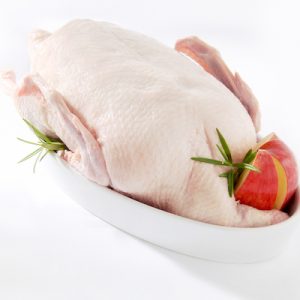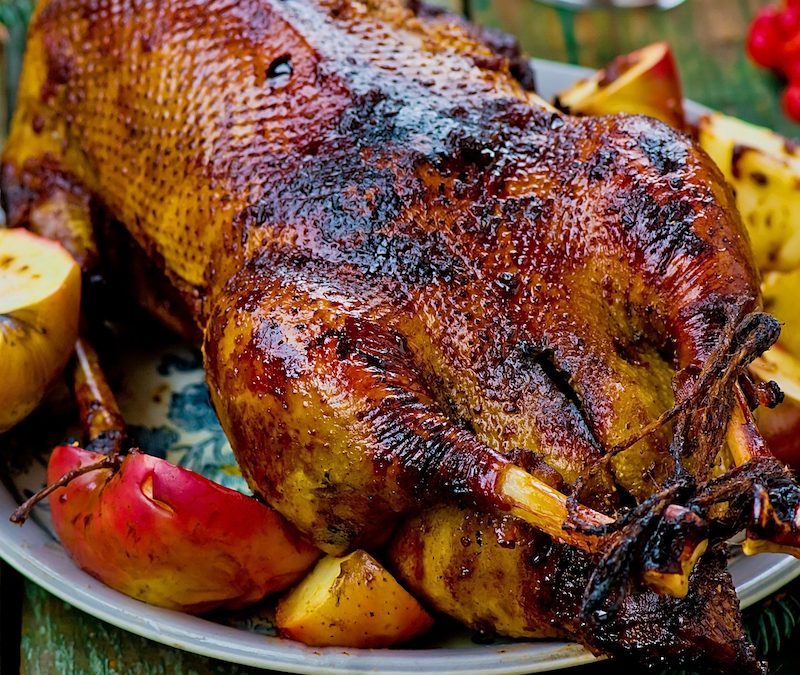Tired of turkey? Try a goose on the grill for this year’s Christmas dinner. Here is a complete guide to help you grill the traditional holiday goose from start to finish.
Turkey or ham may be the centerpiece every Christmas. But that wasn’t always the case. Until recently, no Christmas dinner would be considered complete without the presence of the traditional roast goose.
In fact, many Christmas stories mention roast goose as part of the Christmas dinner. The most popular of these is the Charles Dickens’ classic A Christmas Carol where Scrooge along with the Ghost of Christmas Present look on as Bob Cratchit and his family tuck in and enjoy a delicious roast goose for Christmas.
Whether it’s the deep history and tradition behind the bird or the hangover of having a bit too much turkey for Thanksgiving, one thing is for sure. More and more Americans are now reviving this Christmas tradition of serving roast goose.
Here is a guide to help you choose, prepare and roast a goose for your Christmas dinner this year.
Why Choose a Goose for Christmas?
A lot of people are hesitant about cooking a goose for Christmas. For one thing, the price of goose in the market today is almost the same price as that of a turkey. Pound for pound, turkey seems to have the upper hand since you do get more meat from it. Geese have also been given quite a bad rap because of its high fat content. Not to mention the thought of cooking something new for the first time can be quite intimidating.
In addition to giving you something new yet traditional on Christmas, there are a lot of other reasons to grill or roast a goose.
Naturally designed for Christmas dinner
Many people believe that geese have been brilliantly designed by nature to be feasted upon during Christmas. That’s because geese are best harvested after the freezing weather of winter arrives.
Most—if not all—geese that are sold in the market are free range and don’t have to be “forced” to mature. So you don’t have to worry that the goose you get was fed with any chemicals or medications just so that it is ready in time for Christmas.
Easier to cook
The biggest challenge for anyone grilling or roasting a turkey for Thanksgiving or Christmas is that it comes out dry. Part of this is because of the bird having a low-fat content.
That is not the case when it comes to roasting or grilling goose. Since it has a very high-fat content, it helps keep the meat succulent, moist and full of flavor. In fact, it’s so full of flavor that preparing a goose for Christmas dinner doesn’t need to spend so many hours to marinade and gravy is an option, not a necessity.
Goose fat renders at a lower temperature compared to chicken or turkey. That means that not only is it much easier to cook, especially using an outdoor grill. It also needs a shorter time to roast. That means you can spend lesser time in the kitchen and more time mingling with friends and family that come over for Christmas dinner.
Pairs well with seasonal flavors
The rich, dark meat of a grilled or roasted goose goes perfectly well with many traditional Christmas foods like chestnuts, apples, pears, figs, and plums.
It also pairs so much better with wine compared to turkey. Wine experts recommend pairing roast goose with red wine since it cuts through the rich flavor of the meat. But of course, it is up to your preference.

Choosing a Goose
After reading through the reasons why a roast goose is a great alternative to turkey for Christmas, the next question you probably have is how to pick a good goose for grilling or roasting.
There are two kinds of geese sold in the market: dry geese and wet geese. The difference between these types of geese is in the way how they are dressed and stored.
Dry geese are prepared by using wax to get rid of the feathers. After they are plucked, they are often left to hang, which is why they have a rather dry appearance. These are commonly sold in specialty butcher shops.
Wet geese, on the other hand, are plucked by immersing them in hot water before storing them in bags. These are the most common type of geese you would find in supermarkets because this plucking method is much faster than the dry method.
If you are roasting or grilling a goose for Christmas, try to get a dry goose because the meat is more flavorful. It also doesn’t contain as much moisture as wet geese, which makes it quicker for the marinade to penetrate the goose. More important, dry geese tend to have a crispier skin when roasted or grilled compared to wet geese.
When choosing a goose, carefully inspect the bird to make sure that it has a nice creamy white cap of fat. Also, make sure that you allow 1 ½ to 2 pounds of goose per person as much of the weight is goose fat, which will render out as you grill it.
If you are buying your goose from a butcher, ask if he can already take out the wishbone for you and trim off some of the excess fat. This will make the goose easier to prepare when you get home, and also make it more presentable. Make sure to ask him for all the giblets, too because you will need them when you make the stuffing and gravy.
Preparing Your Goose for the Grill
Now that you got your goose, it’s time to prep it up for the grill.
As with any meat, make sure that your bird is at room temperature. Get some paper towels and pat the skin of the goose dry, even if you got a dry goose since it could still have a bit of moisture on it.
The next thing that you need to do is to pierce the goose all over with a small, sharp knife or fork, taking care that you don’t go all the way to the meat. This not only helps the marinade penetrate through the bird faster. It also serves as an escape route for the fat while you’re grilling it. The fat escaping through the skin is what will make it crispy after grilling.
Once you have done that, you can now marinade your goose. The traditional Christmas goose marinade is very simple. Just some salt and pepper. Rub this inside and outside the goose. If you want, you can add a bunch of herbs inside the cavity of the goose for added flavor.
After rubbing the goose with your marinade of choice, tie the wings and the legs against the goose’s body. It should be tight enough so that the wings and legs won’t spread and stick out oddly while you’re grilling it, but loose enough so that everything gets evenly cooked.
Allow this to sit at room temperature for at least two hours. You can, of course, let it marinate longer if you want.
Firing Up the Outdoor Grill
While waiting for your goose to marinade, it’s time to get your grill ready.
Build a bed of coals and then rake it over to one side since you will be using indirect heat to grill your Christmas goose. Pre-heat the grill to 350 degrees Fahrenheit. If you want to give your roasted Christmas goose a smoky flavor, preheat your outdoor grill up to 400 degrees Fahrenheit and then add a few pieces of hardwood like apple and then close the lid for the smoke to build up. Then reduce the heat to 350 degrees Fahrenheit.
Grilling Your Christmas Goose
If your outdoor grill comes with a rotisserie, insert the spit through the goose’s body and then place the spit into the rotisserie motor. Otherwise, raise the rack of your grill with a stand or some tight aluminum foil balls.
Place a pan underneath the goose to collect the fat that will render out from the goose. This will not only help avoid flare-ups that can cause your goose to burn while grilling, but you can also use this to cook the stuffing and gravy.
Close the lid of your outdoor grill and allow the goose to grill for an hour. Then, open the lid and ladle out most of the fat from the pan. Turn the goose over and allow this to grill for another 90 minutes to two hours. Check if the goose is done by inserting an instant-read thermometer into the thickest part of the thigh. When the thermometer reads 165 degrees, take your goose out and place this on a dish before covering it with aluminum foil. Let the bird rest for 15 minutes to allow the juices to be absorbed again before serving it.
Some Final Tips for Grilling a Goose for Christmas
Don’t use a wet marinade
When marinading your goose, stick to using dry rubs. Don’t use wet marinades since the skin will not become crispy because of the amount of fat that will render out from the bird while grilling.
Rub a thin layer around the skin
Even though your goose will render quite a lot of fat while it’s grilling, it’s still important to apply a small amount of oil on the skin, especially if you don’t have a rotisserie. This is to make sure that your bird doesn’t stick to the grill. The oil will also help start getting the skin of your goose golden and crispy.
Cook your stuffing separately
Although it’s quite common to find many roast goose recipes that say to add the stuffing inside the goose before placing it on the grill, it is still better to grill your goose and cook your stuffing separately. That’s because stuffing your goose prevents the heat from the grill to circulate your bird’s cavity; so it ends up not being cooked evenly.
Instead, cook your stuffing using the fat rendered out from the goose. That way, you can be sure that you get to grill your goose evenly and your Christmas stuffing will still have that slight roast goose flavor.

